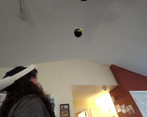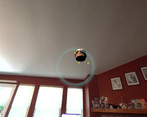Play game
Aaaaaahhh! The Game's itch.io pageResults
| Criteria | Rank | Score* | Raw Score |
| Originality - How original was the entry. | #16 | 3.300 | 4.667 |
| User experience - How well was the user interaction implemented. | #18 | 2.593 | 3.667 |
| Theme incorporation - How well did the entry fit the theme. | #18 | 2.121 | 3.000 |
| Overall | #19 | 2.239 | 3.167 |
| Fun factor - How much fun was the entry to play. | #19 | 2.593 | 3.667 |
| Audio - Did the entry make good use of audio? | #19 | 2.121 | 3.000 |
| Haptics - Did the entry make good use of haptics? | #21 | 0.707 | 1.000 |
Ranked from 3 ratings. Score is adjusted from raw score by the median number of ratings per game in the jam.
Godot version used
["XR Editor"]
Required OpenXR features
Passthrough, Meta Scene, Meta Shared Spatial Anchors
Leave a comment
Log in with itch.io to leave a comment.







Comments
Fun little game, one thing I missed which I think we don't have an option for yet is telling the Quest this is a full passthrough game that doesn't need a boundary, I couldn't fully explore my room. Also the roomsetup when the game was running didn't work well, I had to exit and do a room setup from the settings menu so it was all there before the game began. I got a feeling the Meta UI was clashing with the game.
Sadly it was late here so couldn't find the hamburger for fear I'd disturb the neighbours :)
Thanks for trying it! Yes, boundaryless was an issue; Godot provides a checkbox for boundaryless, which works, but Meta rejected the app and complained about the manifest when I tried to push a boundaryless version to the Meta Horizon Store. After the jam I made an issue in the Godot OpenXR Vendors plugin project about it and David Snopek helped me figure it out, he's already pushed a fix to master (thanks David!). And yeah, the room setup from within the game seems to be giving people problems - I guess I always had my room set up beforehand and didn't notice during the jam.
And no worries, thanks for trying it! Maybe I should have made a slider for the volume threshold to allow more people to try it without disturbing the peace. Ah well.
It's so cool that you made a co-located multiplayer experience! There really aren't enough of those, even among commercial apps in the store.
How did you get the "invite a friend" thing to work? I didn't previously notice that in the API - is it the `MetaPlatformSDK.group_presence_*()` functions? I did a co-located multiplayer game once, but I used a room code system to get connected (but still had the users login via the Platform SDK, so they could share spatial anchors).
Anyway, very cool! And a super impressive thing to build in only a week - playtesting co-located experiences is notoriously hard :-)
Hey David! Thanks for the kind words. 😊 And thanks for asking about the "invite a friend" feature, I was super excited to get that to work!
Yes, to enable "invite a friend", I use Group Presence functions. When setting up group presence, I use the inviter's local IP address as the lobby and/or match name, so that the invited friend knows what IP to connect to. When launching the app normally, the headset acts as a server, but if joining from an invite or deep link, the headset acts as a client. Here is some more info:
1) I followed the "Getting Started" instructions for Godot Meta Toolkit to get the app set up in the store and get Platform services functioning in Godot.
2) In the Meta Horizon Developer Dashboard, I added the following DUC items: "User ID", "Profile", "Deep Linking", "Friends" and "Invites".
3) Also in the Meta Horizon Developer Dashboard, under "Development" > "All Platform Services", I added the "Destinations" service, and created a single destination. I called it "main".
4) In Godot, after initializing the Presence Platform, I check the launch details to see if we're launching normally, or launching from an invite or deep link. If launching normally, I create group presence options with my local IP and make it joinable, and start multiplayer as the host. If launching from invite/deep link, I have the headset connect to the host using the local IP in the launch details. You can see my script here: https://github.com/bschoun/aaaaaahhh-the-game/blob/master/meta_platform.gd I think Meta expects the client to also enable group presence, but I didn't get that working for the jam (it does work without it, you might just get a "Something went wrong" notification in the headset).
To be fair, I've worked with colocation before in Unity and used this technique, so I was able to reference my previous Unity project to get this working quickly. Here are a few of my tricks I use for developing/testing colocated apps:
1) I set a single spatial anchor at (0,0,0) that I save to the cloud and share. All visible shared objects are made to be children of this node. I use a MultiplayerSynchronizer to sync the transform values of the children so that everything is aligned between players.
2) I store the UUID of my spatial anchor locally to a file so I can re-use it. Meta seems to get mad if you create and save too many spatial anchors to the cloud in a short period of time and will lock you out. Happened to me during this project. 😅
3) During development/testing, I always have a virtual object at (0,0,0) showing XYZ directions, to compare what I'm seeing in each headset. I sometimes have a physical object that I will place at the (0,0,0) point, and then look at it from multiple headsets.
4) I have 2 headsets with different profiles. For each one, I use Meta Quest Developer Hub to disable the proximity sensor for a few hours to keep the headset from going to sleep.
5) Then I kind of just swap the headsets back and forth - invite from one, accept from the other, compare positions of everything. For things I can't test this way, I often ask another person to help me test it, or I might cast from one headset and wear the other. Maybe there are better ways I don't know about but this is how I do it.
I think that's it! Regarding Shared Spatial Anchors, just FYI, Meta now apparently supports group-based spatial anchor sharing/loading, which has fewer requirements than user-based. I haven't seen support for this in Godot yet, but maybe I didn't look hard enough since I knew I needed Platform anyway for "invite a friend".
Thanks for all the details!
> Regarding Shared Spatial Anchors, just FYI, Meta now apparently supports group-based spatial anchor sharing/loading, which has fewer requirements than user-based. I haven't seen support for this in Godot yet, but maybe I didn't look hard enough
No, unfortunately, Godot doesn't support this yet, but it's something I've been wanting to add!
It seems fun, but I tried to open it (in my quest 2) several times and it just opened the system menu prompting me to modify my room layout, and the “continue” button just opened the same menu again after some seconds :(
Oh no! Thanks for the feedback, I appreciate it. I haven't tried with a Quest 2, but did notice some occasional weirdness with it asking me to set up the room on my Quest Pro multiple times.
If you feel like trying again, you could maybe try setting up your room before launching the app (Settings > Environment setup > Space setup > Set up), and set up a large roomscale boundary (the app would ideally be boundary-less, but Meta complained when I tried to upload a boundary-less version to the Horizon Store).
I also realized I didn't handle permission requests very well (for spatial data and mic). You may need to restart the app once after installing to get it to function.
If you want to try multiplayer, you'll want to install the Meta Horizon Store version: https://www.meta.com/s/3B9J1gHJF The app uses Presence Platform which doesn't seem to work with sideloading.
Sorry for the janky app and all the technical difficulties! 😅 I appreciate you giving it a try.